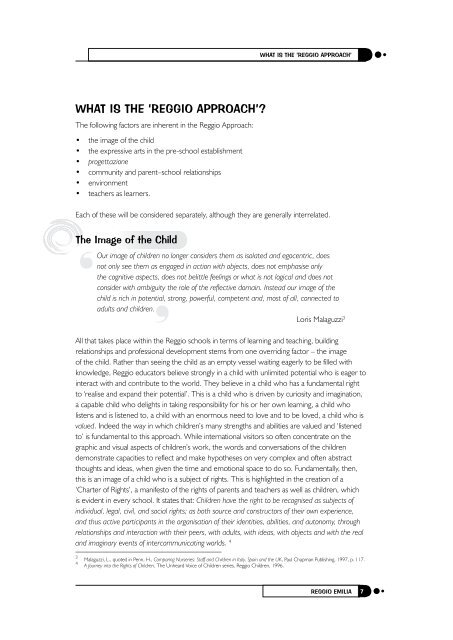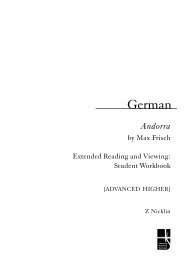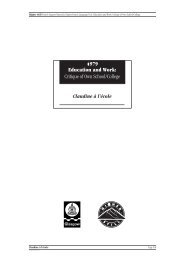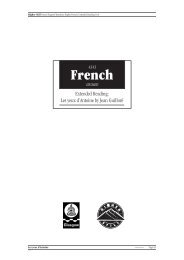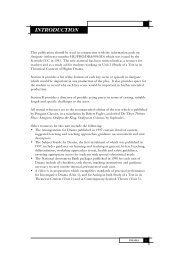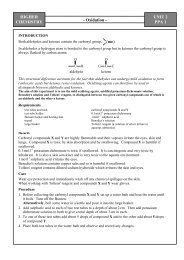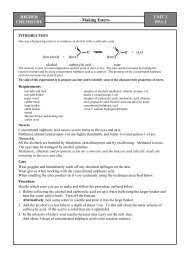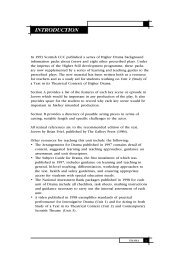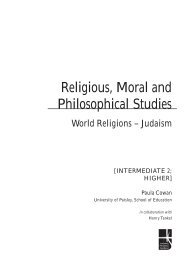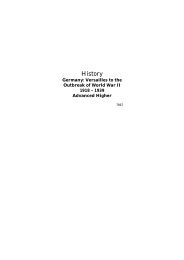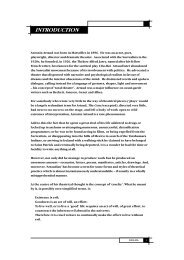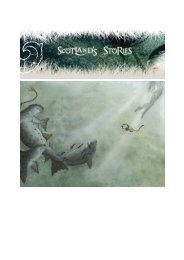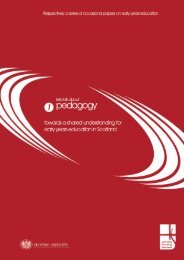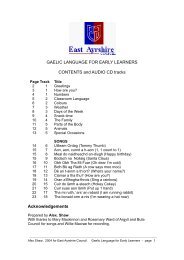The Reggio Emilia Approach to Early Years - Education Scotland
The Reggio Emilia Approach to Early Years - Education Scotland
The Reggio Emilia Approach to Early Years - Education Scotland
Create successful ePaper yourself
Turn your PDF publications into a flip-book with our unique Google optimized e-Paper software.
WHAT IS THE ‘REGGIO APPROACH’?<br />
<strong>The</strong> following fac<strong>to</strong>rs are inherent in the <strong>Reggio</strong> <strong>Approach</strong>:<br />
• the image of the child<br />
• the expressive arts in the pre-school establishment<br />
• progettazione<br />
• community and parent–school relationships<br />
• environment<br />
• teachers as learners.<br />
Each of these will be considered separately, although they are generally interrelated.<br />
<strong>The</strong> Image of the Child<br />
�<br />
Our image of children no longer considers them as isolated and egocentric, does<br />
not only see them as engaged in action with objects, does not emphasise only<br />
the cognitive aspects, does not belittle feelings or what is not logical and does not<br />
consider with ambiguity the role of the reflective domain. Instead our image of the<br />
child is rich in potential, strong, powerful, competent and, most of all, connected <strong>to</strong><br />
adults and children.<br />
Loris Malaguzzi3 �<br />
WHAT IS THE ‘REGGIO APPROACH’<br />
All that takes place within the <strong>Reggio</strong> schools in terms of learning and teaching, building<br />
relationships and professional development stems from one overriding fac<strong>to</strong>r – the image<br />
of the child. Rather than seeing the child as an empty vessel waiting eagerly <strong>to</strong> be filled with<br />
knowledge, <strong>Reggio</strong> educa<strong>to</strong>rs believe strongly in a child with unlimited potential who is eager <strong>to</strong><br />
interact with and contribute <strong>to</strong> the world. <strong>The</strong>y believe in a child who has a fundamental right<br />
<strong>to</strong> ‘realise and expand their potential’. This is a child who is driven by curiosity and imagination,<br />
a capable child who delights in taking responsibility for his or her own learning, a child who<br />
listens and is listened <strong>to</strong>, a child with an enormous need <strong>to</strong> love and <strong>to</strong> be loved, a child who is<br />
valued. Indeed the way in which children’s many strengths and abilities are valued and ‘listened<br />
<strong>to</strong>’ is fundamental <strong>to</strong> this approach. While international visi<strong>to</strong>rs so often concentrate on the<br />
graphic and visual aspects of children’s work, the words and conversations of the children<br />
demonstrate capacities <strong>to</strong> reflect and make hypotheses on very complex and often abstract<br />
thoughts and ideas, when given the time and emotional space <strong>to</strong> do so. Fundamentally, then,<br />
this is an image of a child who is a subject of rights. This is highlighted in the creation of a<br />
‘Charter of Rights’, a manifes<strong>to</strong> of the rights of parents and teachers as well as children, which<br />
is evident in every school. It states that: Children have the right <strong>to</strong> be recognised as subjects of<br />
individual, legal, civil, and social rights; as both source and construc<strong>to</strong>rs of their own experience,<br />
and thus active participants in the organisation of their identities, abilities, and au<strong>to</strong>nomy, through<br />
relationships and interaction with their peers, with adults, with ideas, with objects and with the real<br />
and imaginary events of intercommunicating worlds. 4<br />
3 Malaguzzi, L., quoted in Penn, H., Comparing Nurseries: Staff and Children in Italy, Spain and the UK, Paul Chapman Publishing, 1997, p. 117.<br />
4 A Journey in<strong>to</strong> the Rights of Children, <strong>The</strong> Unheard Voice of Children series, <strong>Reggio</strong> Children, 1996.<br />
REGGIO EMILIA REGGIO EMILIA


